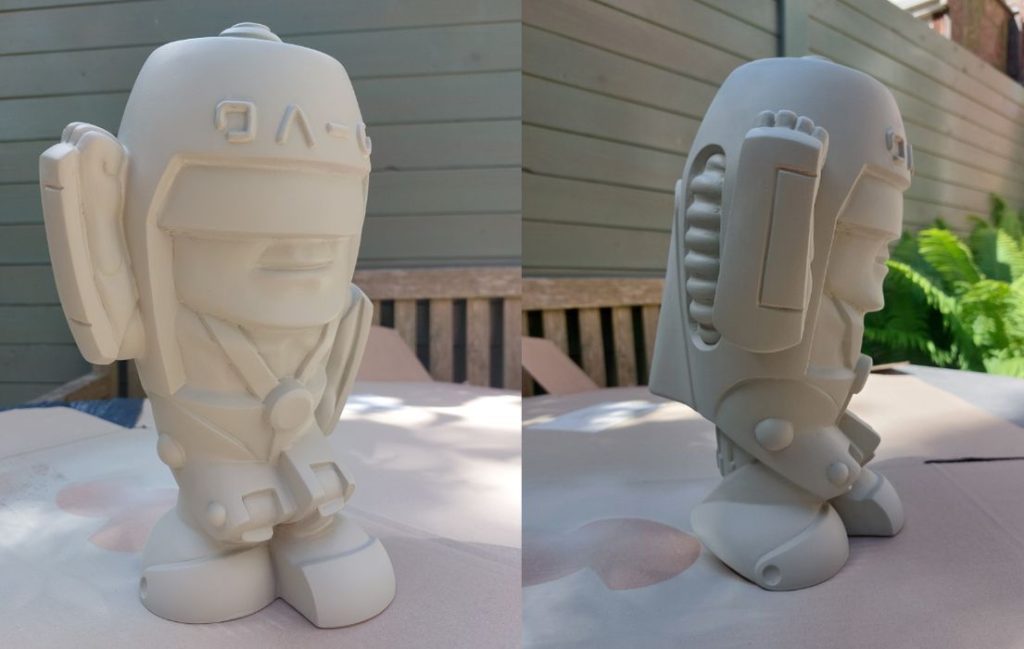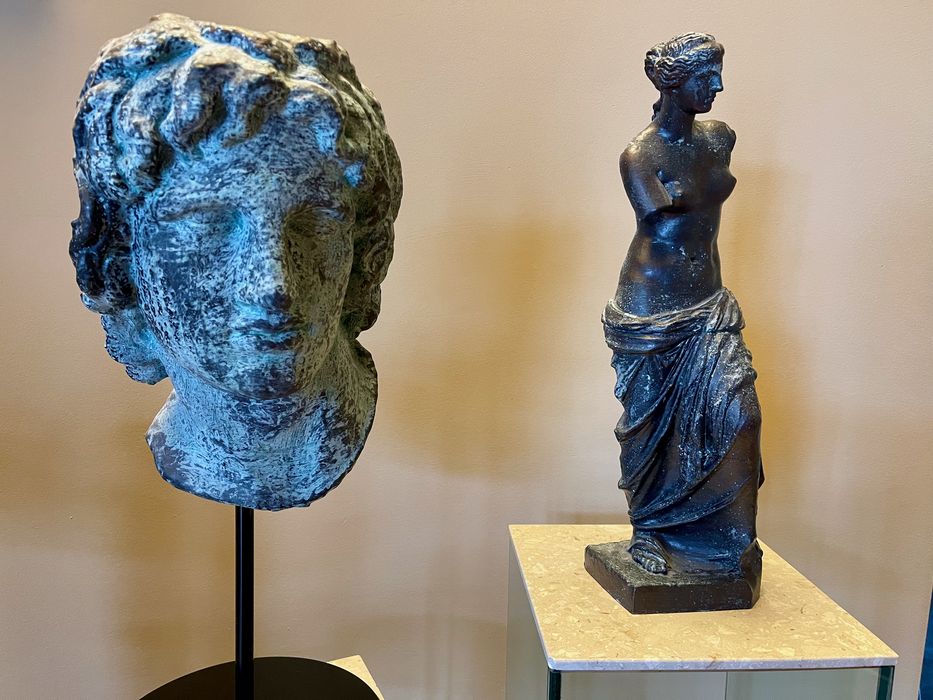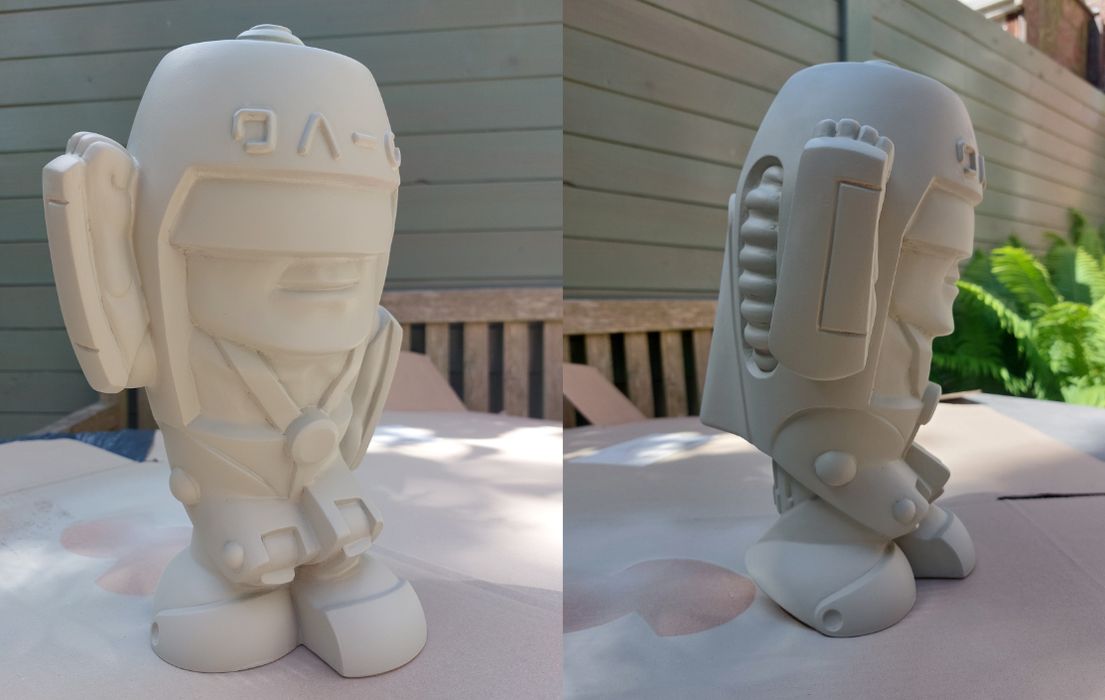
This week’s question is all about large-format 3D printing.
Fabbaloo reader Murphy Loewy is a successful Dutch sculptor who creates original works. Loewy’s process is to first create clay models and then use reverse engineering techniques to generate 3D models. These are then 3D printed in limited sets.
Loewy writes:
“I recently created a mascot/action figure for a large Dutch firm with 200 employees and 3 offices in the Netherlands. For each of the offices I’m supposed to produce a 2 meter tall version of the figure, so that’s 3 figures of 2 meters tall. One in chrome gold mirror finish is to be the main eye-catcher of their flagship office in one of Holland’s most up-and-coming hotspots featuring art exhibitions, restaurants, cinema and cultural events. Another figure will be in plain white for their 2nd office and a 3rd in a still to be determined finish for the 3rd office location. I’m looking for prints in SLA technology, or any other smooth surface and lightweight printing technique.”
Loewy seeks a low-cost provider that can produce this sculpture in four parts or less for assembly. You can see views of the sculpture at top.
With four parts, this implies the printer that produces these parts must have a build volume of at least 500mm on one axis, which greatly reduces the options possible for this project.
It is possible to squeeze in a large print into a smaller build volume by tilting the object for printing, but this could result in a massive amount of support material that would have to be removed and would also produce a lot of rough surface to be polished.
Loewy suggests using the SLA process, which can produce relatively smooth finishes. Indeed, some of the finest prints I’ve done have been on resin 3D printers — with the layer lines being virtually invisible.
The difference here is that this is a rather large print. Large-sized objects generally don’t require such high resolution because the eye cannot distinguish the layer lines unless looking very closely, which doesn’t happen on large objects like furniture or sculptures.
On the other hand, Loewy said one of the three sculptures is to have a “chrome gold mirror finish”, which suggests you really do need a perfectly smooth surface.
SLA 3D Printing Options
The problem here is that SLA 3D printing is expensive, mostly due to the cost of resin, but also because of the rarity and cost of large-scale SLA printers.
That said, there are multiple 3D printer options in that space, including:
- Stratasys NEO 800 (800 x 800 x 600 mm)
- 3D Systems’ ProX series (up to 1500mm in length)
- Farsoon HT1001P-2 (1000 x 500 x 450 mm)
- Photocentric (up to 510mm)
There are likely a couple more options, but these machines and companies operating them could certainly produce these parts. The issue will be the expense in doing so.
Another possibility is to avoid expensive SLA solutions and use more inexpensive 3D printing processes. There are multiple FFF large-format options, but as you might expect the prints will be somewhat more coarse than received from an SLA 3D printer.
The solution would be to smooth the surface of the parts sufficiently to allow for a proper chrome finish. This is entirely possible, and it doesn’t require tedious and lengthy sanding and polishing of the entire surface. Instead it’s possible to apply a few coats of any of several spray-on epoxy materials that would harden into a very smooth finish, likely even smoother than one would receive from an SLA print.

Above are some larger (500mm tall) 3D prints I’ve personally made using FFF 3D printing that are composed of several sections and glued together. I was easily able to smooth them and bronze the surfaces. This effect would be even more effective on a larger sculpture.
FFF 3D Printing Options
Large format FFF options include:
- BigRep Pro, Studio or ONE (up to 1000mm)
- 3DPlatform (up to 1500mm)
There are plenty of other FFF options that offer machines with up to 500mm on an axis, but I would stay with companies that have specifically designed large format FFF 3D printers — there are a number of printing challenges at that scale that many 3D printer manufacturers new to large formats have not yet solved.
Other options
There are several other large format options that should be mentioned.
CADzilla is an Australian 3D print service that operates an enormous delta FFF 3D printer with a build volume of 2400 x 2400 x 3000 mm. With that space it’s likely they could produce ALL THREE sculptures in one piece in a single print job.
However, their output would be somewhat coarse and would require a smoothing treatment similar to FFF approaches.
Massivit manufactures a large format 3D printer with a volume of 1450 x 1800 x 1110 mm. Again, this might be able to produce the sculptures in one piece rather than several for assembly. The purpose of their equipment is to produce large sculptures and advertising artifacts. Their process uses an unusual photopolymer gel deposition process that is quite rapid and is similar to SLA, except that the surface quality is coarse. It might be possible to smooth the surface, as I believe they’ve done so in previous projects, but it would be best to contact them to discuss.
Getting a Print
If those are the technical options, how would one get them done? In this case it would be very unwise to consider acquiring the equipment, as this is a one-time project. Some other party has to do the printing.
There are basically two approaches here.
The first option is to contact the manufacturers listed above directly. Many 3D printer manufacturers operate print services either directly or through a subsidiary. These operations would be happy to discuss a project of this type.
Some 3D printer manufacturers don’t sell equipment, but instead just operate them in-house and provide services. CADzilla would be one of those.
The second option is to consider using a manufacturing service. These are operations that have invested in a variety of different types of equipment and offer the ability to obtain prints from different technologies by highly trained operators. Often they service one-time clients, as is the case here.
These services very often have clients arriving without knowledge of the best approach, and they are accustomed to identifying practical options for production of the parts. Often they will recommend a particular technology as it might provide a quality or cost advantage. They are also often skilled in finishing processes, as this could be necessary depending on the technology chosen.
Some services of this type to consider include:
- FATHOM
- Fast Radius
- GKN
- Jabil
- Materialise (located nearby in Belgium)
There are no doubt other options here, particularly those operating on a regional basis that I am unaware of.
Note that there are several “upload design and order a print” services, but I suspect there is a need for some consulting here to ensure the proper technology is used, so I would avoid them for now.
It’s very likely you would be able to determine an effective solution by contacting one of the above and discussing the requirements.

